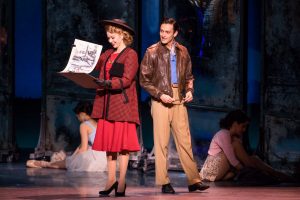THE DANCING ENTRANCES,
BUT THE BOOK DOESN’T STAND A CHANCE
Back in the era that spawned musicals with tunes by Gershwin, Kern, Porter, and Rodgers, the Broadway Musical Comedy book was almost unnecessary. The 1920s and ’30s saw shows constructed piecemeal’”a comic star here, a songwriting team there, whoever was available, really. The cliché-ridden plots and dubious groaners therein were more often than not something to endure until we got to the next great tune and the dazzling choreography it inspired.
Welcome to the national tour of Craig Lucas’s adaptation of MGM’s milestone 1951 motion picture, An American in Paris. It’s shameful that a ball-and-chain script is attached to some of the most luminous dancemaking in recent Broadway history. Here, romance is heightened by the dance, and made dour by the libretto. In fact, the lines seem to intrude on director/choreographer Christopher Wheeldon’s sumptuous blend of ballet and athletic modern dance, the kind of lush, luminous movement that will have some viewers swooning right to the box office after the show to buy another ticket. This tour is additionally recommended for a talented ensemble made up of old-fashioned triple-threats whose stamina (how many toe-shoes must they go through a week?) is nothing short of remarkable.
Picking up where screenwriter Alan Jay Lerner left off, Lucas centers his story around three artists: American Jerry (Garen Scribner), a painter who settles in Paris as it recovers from WWII; his pal and fellow ex-patriot Adam (Etai Benson), who dreams of composing serious music; and Henri (Nick Spangler), a Frenchman who dreams of becoming a song-and-dance man in America. Milo Davenport (Emily Ferranti), a rich American heiress (is there any other kind?) commissions a new ballet to be composed by Adam and designed by Jerry, which will star a lovely but elusive gamine ingénue, Lise (Sara Esty), with whom all three boys will fall in love.
Lucas smartly adds the devastating repercussions of war in the guise of injuries, secrets, and the strong desire to rebuild into something better and brighter. You can’t have a richer context for romance and heartbreak and laughter, but the book simply doesn’t fly. What could have been a substantial libretto that balances humor, pathos, and storytelling, is unnecessarily cliché-ridden, manipulative, and cheap (at one point, Adam’”played in the film by Oscar Levant’”jokingly refers to himself as Oscar Levant). And for no reason it’s Adam’s memory play, starting and ending with him and a piano breaking the fourth wall. And the darker material isn’t cause for cathartic tears; it’s more like a jeremiad compared to the jaunty, jazzy music and dance. Additionally, Christopher Austin and Bill Elliot’s orchestrations and Sam Davis’s dance arrangements aren’t nearly as beguiling and inventive as the great MGM arranger, Conrad Salinger.
It’s quite normal for songs by the Gershwin brothers and their contemporaries to end up willy-nilly in any given jukebox musical, so the deletion of five tunes from the film is fine, but the new songs feel squished into the dialogue, and the discerning patron will notice the euphemistic fat hanging over the tight bathing suit. This inadvertently emphasizes the over-complicated plot instead of relieving its pressure points. The one song that should not have been removed from the movie would have worked perfectly here, but “Nice Work If You Can Get It” was clearly excised because the same-titled musical with Kelli O’Hara and Matthew Broderick had just closed on Broadway two years prior to American‘s opening.
Fortunately, escapist entertainment arrives with the eleventh-hour one-two punch of a fun fantasy sequence with tap-dancing and top hats (“I’ll Build a Stairway to Paradise”) and the eye-popping spectacle of the titular 1928 17-minute jazz-influenced symphonic poem. It’s truly glorious. Bob Crowley’s costumes are beautifully designed to evoke mid-40s’ styles while fitting the dancers perfectly. It’s just too bad that the script is a series of monochromatic patches, resembling the Mondrian paintings that inspired Crowley’s sets.
photos by Matthew Murphy
An American in Paris
national tour
reviewed at the Pantages Theatre (L.A. run ends ends April 9, 2017)
for tickets, call 800.982.2787 or visit Hollywood Pantages
tour continues through July, 2018
for dates and cities, visit An American in Paris













